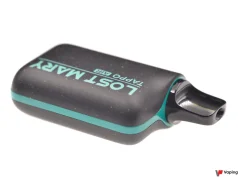
From in vitro models to human health
An increasing number of researches carried out in vitro on e-vapor indicate that vaping may increase the risk of infections in airways. The cell model is often a modified strain of the airway epithelium exposed to levels that are far beyond exposure levels produced by regular use of e-cigarettes. The authors generally make use of the precautionary principle when concluding and state that vaping should be avoided, that the absence of long-term studies prevents them from drawing further conclusions.
All such studies, when snatched by the media, are associated to misleading headlines indicating that vaping is dangerous, that it should be more regulated by national agencies because they address the primary risk and not the risk of vaping compared to smoking.
Vaping is not the safest habit, e-vapor brings potentially harmful compounds but…
In a recent BBC documentary, the journalist and physician Michael Mosley initiated with vaping and sustained this behavior for the needs of his documentary. He underwent medical tests to evaluate the potential benefit of vaping on himself and reported increase in expired nitric oxide, a marker of the inflammation confirmed by the presence of numerous macrophages in sputum samples, as the consequence of a stress that is induced by each puff on his device.
Users believe that their health’s improved after switching to e-cigarette
However, on social media, most comments by e-cigarette users illustrate the fact that, by switching to vaping, they improved their general health. Most people report that they could take the stairs again, that they could walk, even run without being breathless. Such health improvements are considered grounded science unless a survey is carried out by scientists, showing that a certain significative percentage of the population report improvements.
A few study carried out on humans report no significant adverse respiratory effects consecutive to vaping. This is, for example, the case of a survey of asthmatic smokers who had been proposed to try e-cigarettes. The ECLAT survey brings scientific poofs of benefits for general health with improvements in blood pressure, body weight control.
A new step in the understanding is carried out by Joanna Astrid Miler, Bernhard Mayer and Peter Hajek from the Department of Pharmacology and Toxicology of the University of Graz (Austria) and the Queen Mary University of London’s Wolfson Institute of Preventive Medicine.
According to the senior scientist Professor Peter Hajek “There is no doubt that e-cigarettes are much safer than conventional cigarettes, but smokers are still led to believe that they’re dangerous”, he said to the QMUL’s news.
This misinformation includes a misreported study on rats that claimed that vaping may increase vulnerability to infections. These new findings from human vapers show that this is not the case.
Online survey of German vapers
For the first time an online survey was carried out in Germany across social networks of vapers that may be considered “experienced vapers” since they have reported using a third generation e-cigarette for at least two months after smoking cessation.
The authors decided to address subjectif changes in benign respiratory symptoms like colds but excluded chronic lung diseases.

A vast majority of vapers (66%) admit that vaping is beneficial to their health with regard to respiratory infections. In addition to the 941 direct answers, 247 qualitative responses have been made by participants among which the most representative positive statements:
- “As a smoker I had an almost continuous cold. I’ve been a vaper for almost 2 years, and for almost 2 years I’ve had no sniffing, no cough, nothing…”
- “I’ve been vaping for 13 months and had none [infections] while earlier I had colds and sore throat 2-3 times a year.”
- “I’ve been vaping for 2 years and in this time I had one flu-like infection. As a smoker I used to have them at least twice a year, for weeks at a time. I used to have to deal with a persistent cough and mucus production. Нis year the infection had passed within 3 days.”
In contrast, some others responded in a more nuanced way that makes think that the switch to vaping in not the only cause of a worsening of the situation:
- “I smoked for 15 years and in those 15 years I was never really ill. After quitting smoking I have already had 2 flu-like infections […].”
- “I have completely switched to vaping in 2009. At that time, the first 3 smoke-free years I was definitely sick less often than during my smoking years. But I have observed that I have been sick more often in the last 3-4 years (a cold about 4-5 times a year). However, I must say that I became a father 4 years ago. Maybe it has to do with my daughter – she often passes on her infections to me. I’m mostly ill after she has been ill.”
Relevance of flu-like infections among vapers may be related to a weakening of the aerial track defences but more likely to the recent spade of ore virulent influenza strains. The different steps of socializing with young kids, for the second case, often corresponds to more illnesses among family members.
Undoubtedly, such surveys carried among communities like forums or social media groups are not expected to bring negative views on the subject. Most of the respondents switched to vaping on their own initiative and succeeded in quitting smoking. This may constitute a bias in the sampling, as well as the self-exclusion of vapers who encountered problems when switching vaping and decided not to use e-cigarettes (allergy to propylene glycol is the most common). But the authors specify that the positive light counteracts “the general anti-vaping ethos of public health and media coverage of vaping“.
The authors evoke the biocide action of propylene glycol to justify the improvement in respiratory health. For the specialists, it is the second benefit after cutting down with smoking and its load of harmful and aggressive compounds.
 Professor Peter Hajek is the author or co-author of 147 publications among which two books and many book chapters. His main attraction pole is smoking cessation. After having studied NRTs, he decided to turn to e-cigarette as another tool to fight against vaping. Hajek is in favor of risk ponderation for regulating e-cigarette and declared to the BBC in 2014: “I think any responsible regulator proposing restricting regulation has to balance reducing risks with reducing potential benefits“. The researcher is also very critical about WHO’s position on e-cigarette. He has been one of the co-authors of the Cochrane Review of the effectiveness of electronic cigarettes for smoking cessation that paved the way to the PHE and RCP‘s pro-vaping positions.
Professor Peter Hajek is the author or co-author of 147 publications among which two books and many book chapters. His main attraction pole is smoking cessation. After having studied NRTs, he decided to turn to e-cigarette as another tool to fight against vaping. Hajek is in favor of risk ponderation for regulating e-cigarette and declared to the BBC in 2014: “I think any responsible regulator proposing restricting regulation has to balance reducing risks with reducing potential benefits“. The researcher is also very critical about WHO’s position on e-cigarette. He has been one of the co-authors of the Cochrane Review of the effectiveness of electronic cigarettes for smoking cessation that paved the way to the PHE and RCP‘s pro-vaping positions.
Miler AJ, Mayer B., Hajek p., 2016. Changes in the Frequency of Airway Infections in Smokers Who Switched To Vaping: Results of an Online Survey, J Addict Res Ther, 7:290 DOI: 10.4172/2155-6105.1000290












any vape tank or rda will spit ejuice while vaping meaning you are getting raw liquid ejuice in your lungs, and some ejuice has impurities in it, so it is entirely possible to get an infection from vaping.
about infections… heres just a thought.
my friend also vapes as do i and just recent had a chest and throat infection.
after lengthy discussions i simply asked her when is the last time u cleaned the mouthpiece?
the answer was….. never.!
think about it…
where there is space there is bacteria.
bri
Professor Hajek was happy to persecute smokers for decades and only now is he beginning to realize it was never really about improving public health. in the real world studies regarding the long term effects of propylene glycol were completed in the 1940s. The substance was registered with the FDA in 1950, “for use in hospitals as air disinfectants.” Propylene glycol is still used in commercial air sanitizers.
Why don’t any of these public health “experts” seem to know any of the basic facts about propylene glycol?
The case of propylene glycol is not that simple.
Propylene glycol, used as a disinfectant in hospitals, is not heated but sprayed. With e-cigarettes, PG is heated beyond its boiling point (188°C) and vaporized with other organic compounds. The thermal degradation of PG that occurs at high temperature and the reactions with other molecules may bring some volatile organic compounds (VOCs), especially aldehydes, in the game and a scientific debate should focus on the temperatures used in e-cigs to keep the risk as low as possible.
Where are you getting “beyond (188°C)” from? It is not necessary to heat a liquid past its boiling point to obtain vapour. Go heat some water on the stove and observe the temperature where vapour forms. It is always much lower than 100°C.
As I write this I am vaping at 340°F or about 171°C. There are not a lot of aldehydes in the vapour because I am sensitive to them and do not detect a soapy taste when I vape at 340°F or 4 to 8 watts on my mods without temperature control. There are many vapers that vape 18 to 24 mg/ml liquid at 4 to 8 watts because it costs much less to vape high nicotine e-liquid at low power than low nicotine liquid at high power.
This is wise, but not all vapers are so reasonable with power.
From a physical point of view, the boiling temperature only depends on pressure for a given liquid. For a mixture of liquids with different boiling temperatures, it’s much more complex. I don’t know the average boiling point of the e-liquids you are using since it certainly contains a bit of alcohol, water, PG, VG and many other constituents and I have no doubt that around 170°C, it is much safer than at 300°C.
I must warn you that your belief that it is not necessary to heat a liquid past its boiling point to obtain vapour is not true. I agree that the surface of the water in your pot may well be at a lower temperature (because it is exposed to thermal exchange with the atmosphere) than boiling, giving the impression that water boils at this temperature. But it is a false impression.
On the stove, the bottom surface where bubbles of vapor appear must reach at least 100°C (more or less depending on pressure) to allow the water to change phase from liquid to gas. And the liquid remains at its boiling temperature as long as a gas phase and a liquid phase co-exist in your pot.
I am convinced that you are right about the absence of extra aldehydes formed by thermal degradation according to your settings. But this is on paper only. In reality, it is much more complex.
I imagine that you trust in your 171°C or 340°F.
Be very careful with this number, the temperature that you set on your device is not an absolute number since the temperature control mode, although it provides much more safety than old cartomizer models, requires a strict procedure for calibration.
The temperature you read on your device is returned from a curve of resistance vs temperature. The temperature you read depends on the slope (the thermal coefficient of your wire) of this curve and on the initial resistance number that is measured at room temperature (theoretically at 20°C but here again, there is generally no precise value written in the manual). Metals and alloys have different slopes and return more or less precise temperature because of the steepness of this slope. But this is always an approximation of the real temperature of the coil since your box is not designed like a thermocouple (which would require an internal reference resistance).
Complicating the task is the regulation of temperature that is a dynamic process where a processor delivers spikes of current and reads the resistance to reach the resistance threshold that corresponds to the final temperature you want. And who says a dynamic process excludes a steady state, which would be the ideal case for a coil.
In all cases, the resistance value that is used for temperature is an average of several consecutive measurements. It is also an average over the distance between the two poles of your box. A direct consequence of that is that the wire doesn’t heat homogeneously and that the temperature reached locally may well be much higher (considering that there are also colder parts, like the legs) than what you expect. Only a thermal scan in the IR can give you the real temperature range of your coil.
Always remember that temperature control is an option of your chipset, not a regulatory requirement, and that no certificate issued from a metrological office comes with the box for the precision and accuracy of the measurements it makes. One should keep in mind that an e-cigarette has never been designed as a precision thermometer.
I believe that manufacturers should make recommendations for the temperature to apply to their e-liquids. It is much more important than to list in detail the ingredients of the mixture that nobody will read.
High power vaping is a fairly recent development and there are still many people vaping 12 mg/ml to 36 mg/ml juice at under 10 watts.
As to aledehydes most serious researchers agree with what was pubished in a famous letter to the NEJM just over two years ago. They wrote, “At low voltage (3.3 V), we did not detect the formation of any formaldehyde-releasing agents […]”. [The authors of the letter did not explain why they quoted voltage when the heat being produced by the heating coil should have been expressed as wattage.]
Evaporation can be complicated. A pail of water left outside on hot days will eventually evaporate completely even though the pail’s temperature never exceeds 45° C and the boiling point of the water is around 100° C. There is a lot of vapours in nature that did not come from boiling liquids.
My liquid, which I blend myself, is composed of around 49% USP PG (b.p. 370.8°F or188.2°C), 49% USP glycerine (b.p. 554°F or 290°C), and 2.0 % nicotine (b.p. 476.6°F or 247°C). Even though my mod is set to 340°F or 171°C which is well below the b.p. of any liquid component of the fluid it still produces plenty of vapour and there is a noticable throat burn from the nicotine. This is something I observe on a daily basis.
The best way to know if the vapour contains aldehydes is to purchase an ambient aldehyde meter and use it. Formaldehyde levels have been restricted in the workplace for decades and the meters are readily available from major hardware stores for a reasonable price. There is no need the theorize about what can be easily measured.
The reason, I think, why Paul Jensen and hi co-authors quoted voltage instead of wattage in this publication is because there were only one type of resistance compatible with the devices they used (eGo batteries).
http://www.vapingpost.com/2016/11/02/a-quick-demonstration-of-formaldehyde-levels-produced-by-an-ecig-a-cigarette-and-a-cigar/
Everyone is free to reproduce the experiment that David Cranfield did with his aquarium. It is not robust science but it gives a good idea of the amount of VOCs contained in e-vapor.
Evaporation is a very particular case of vaporization that is driven by a gradient of partial pressures across an air-water interface. What creates the flux of water from the liquid phase to the air is the difference in saturation. It is helped by air motion and occurs faster in warm environments.
You will never produce satisfying volumes of water vapor at 45°C.
If you set up your e-cigarette at a temperature lower than the lowest boiling point of your blend, it shouldn’t create vapor. If some vapor is created, you have three solution:
1- You’ve got water in your mixture and your temperature is not too bad. This water is vaporized and creates droplets with the other constituents of the mixture. Good news in this case, no or a minimum of thermal degradation occurs during the process and the level of VOC is kept minimal.
2- Your temperature control is not accurate and your real temperature is higher than expected. The reasons are linked to the calibration and the computation of temperature by the chipset.
3- The average temperature corresponds to your reading but some parts of your coil are heating at a much higher level than others. The creation of hot spots is a severe issue that drastically affects the safety of users.
The old physics did not measure heat transfer using volts but watts (joules per second). The NEJM letter did not mention the resistance of the coil but even if it did they still should have calulated the power level in watts and published that instead of voltage. Voltage by itself does not indicate how much something will heat up.
For ages I was vaping at temperatures far below the boiling point of my liquid and deluding myself into believing the vapourizer was giving off satisfying amounts of vapour. Now I know better but since I cannot afford to vape at higher power I will continue to vape at the low temperatures I have been using. Of course, because of your clarification, I will no longer be satisfied or believe the device is producing a significant volume of vapour. Thanks for explaining what was really happening.
You’re welcome, Murray.
You know, even if the power had been advertised by the authors, the scientific laws behind vaping are still very complicated and poorly understood, yet. The atomizer itself has its own signature of the emissions because of the way it is designed, the quality of the wick, the shape, the mixing with air… Science has first to determine the “lowest common denominators” to make progress in this field.
I believe that regulation is not necessarily bad for the consumer. It would allow, for example, to set up quality standards for the heating component, and raise the overall quality.
I run a vape shop and the vast majority of my customers vape at ( between ) 90-120F, which is roughly 40C. Nobody, I mean absolutely nobody I know of vapes anywhere near 188C. That’s just friggin’ ridiculous…..
P.S. – In our four years of business, we have seen HUNDREDS of people quit cigarettes….
P.S.S. – And yes, a greater (>50% ) number of customers have “weened” themselves down to 3-0% nicotine…..